A low-loss and high-efficiency artificial propagation method for Taiwan loach
An artificial breeding and high-efficiency technology, applied in fish farming, climate change adaptation, animal husbandry, etc., can solve the problems of lack of clear reports, high mortality, lack of theoretical basis, etc., to reduce mortality losses, improve synchronous maturity, The effect of increasing the rate of oxytocin
- Summary
- Abstract
- Description
- Claims
- Application Information
AI Technical Summary
Problems solved by technology
Method used
Image
Examples
Embodiment 1
[0023] Example 1 (early May):
[0024] According to the above step (1), 50 kg of parent loach was cultivated; in early May, 300 12-month-old female loach and 300 male loach were selected according to the above step (2); artificial induction was carried out according to the above step (3), and the overall induced labor rate reached 94%. %; Carry out artificial insemination according to the above step (4), the overall fertilization rate reaches 98%, and the hatching rate reaches 85%; follow the above steps (1), (2), (3), (4), especially step (5) A series of operations were carried out for postpartum pro-loach care, and the survival rate of post-partum pro-loach reached 86%.
Embodiment 2
[0025] Example 2 (early July):
[0026] Follow the above steps (1) to cultivate 60 kg of parent loach; in early July, select 300 14-month-old female loach and 300 male loach according to the above step (2); artificially induce labor according to the above step (3), and the overall induced labor rate reaches 95%. %; Carry out artificial insemination according to the above step (4), the overall fertilization rate reaches 99%, and the hatching rate reaches 83%; follow the above steps (1), (2), (3), (4), especially step (5) A series of operations were carried out for postpartum pro-loach care, and the postpartum pro-loach survival rate reached 85%.
Embodiment 3
[0027] Example 3 (early September):
[0028] According to the above step (1), 70 kg of parent loach was cultivated; in early September, 300 16-month-old female loach and 300 male loach were selected according to the above step (2); artificial induction was carried out according to the above step (3), and the overall induction rate reached 92 %; Carry out artificial insemination according to the above step (4), the overall fertilization rate reaches 98%, and the hatching rate reaches 82%; follow the above steps (1), (2), (3), (4), especially step (5) A series of operations were carried out for postpartum pro-loach care, and the survival rate of post-partum pro-loach reached 87%.
PUM
 Login to View More
Login to View More Abstract
Description
Claims
Application Information
 Login to View More
Login to View More - R&D
- Intellectual Property
- Life Sciences
- Materials
- Tech Scout
- Unparalleled Data Quality
- Higher Quality Content
- 60% Fewer Hallucinations
Browse by: Latest US Patents, China's latest patents, Technical Efficacy Thesaurus, Application Domain, Technology Topic, Popular Technical Reports.
© 2025 PatSnap. All rights reserved.Legal|Privacy policy|Modern Slavery Act Transparency Statement|Sitemap|About US| Contact US: help@patsnap.com

